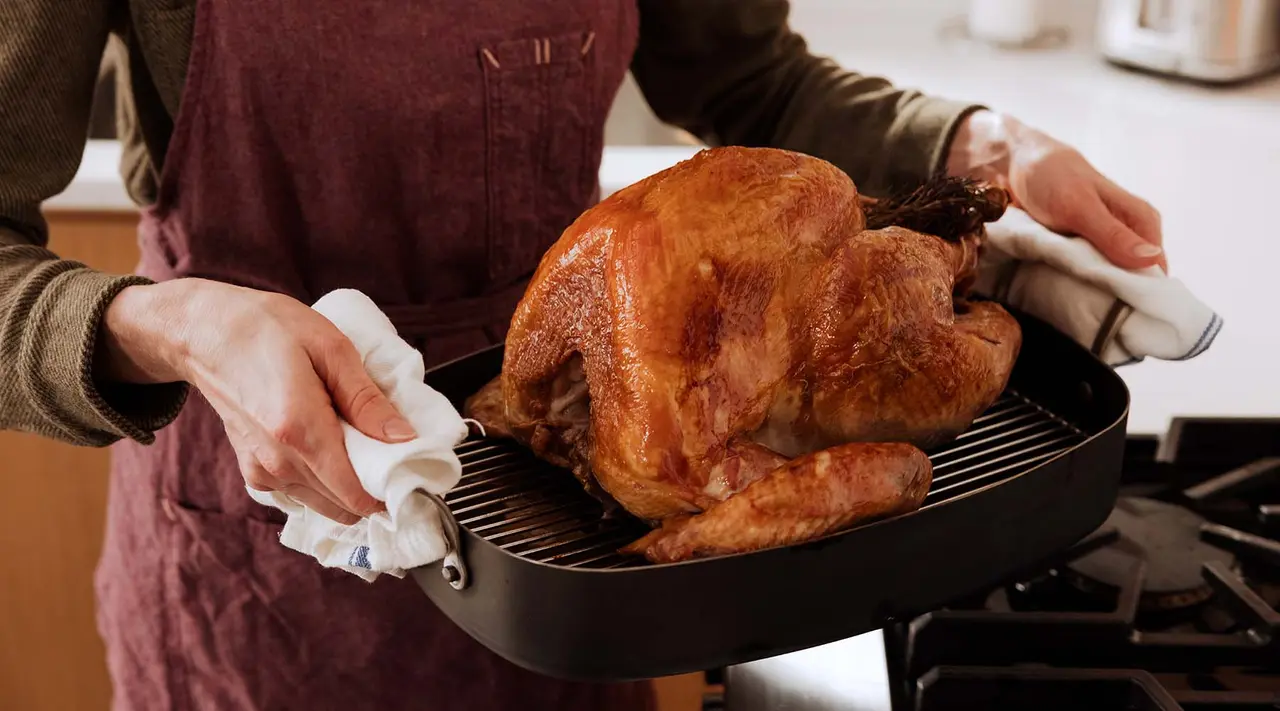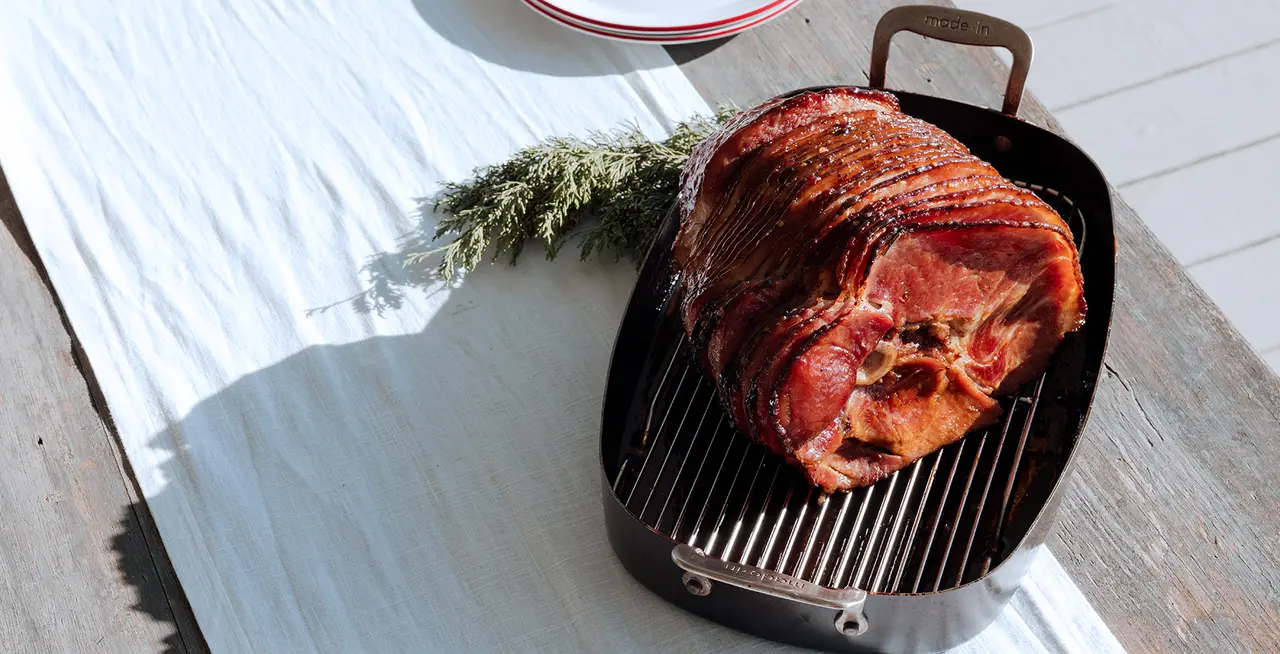The large format bird aspect of a roasting pan might make it seem like something used only for holidays or other special occasions, but it’s definitely worth using more than just a few times a year.
Even if you don’t eat meat, our Roasting Pan’s design proves versatile for all manner of vegetables, from roots to tubers and beyond. Here’s why you should have one in your kitchen all year round.
What Is a Roasting Pan?

A roasting pan is a large, oven safe pan meant for—you guessed it—roasting. It’s far from a one-trick pony, though. Roasting pans also typically include a removable rack, used to elevate a large protein—think whole chicken or turkey—above a bed of vegetables below. This lets the meat’s flavorful juices drip down and flavor what’s underneath, but also provides air circulation so that the bottom of the meat gets crisp, too.
A roasting pan is designed to withstand high temperatures for long periods of time—no warping or buckling here. Unlike sheet pans, which feature shallow sides, our Roasting Pan has tall, straight walls that trap heat inside, meaning your food will cook evenly and crisp nicely while maintaining moisture within.
What Are Roasting Pans Made of?
Roasting pans are usually made of heavy duty metal, such as stainless steel or cast iron. Heavy duty is key for roasting pans, as they can handle bigger tasks like whole birds, beef roasts, and hams. Occasionally you’ll see roasting pans with a non stick coating, which can be nice for super simple clean up, but isn’t recommended for higher roasting temperatures. You may also be familiar with the disposable aluminum roasting pans found in grocery stores, and while they work in a pinch, those are best avoided—they don’t brown food very well, and their flimsy nature makes them prone to spillage.
Our Roasting Pan, made in collaboration with chef Tom Colicchio, is crafted from carbon steel. This means the pan heats up quickly and retains heat exceptionally well. Also key: our pan is small enough to fit on a stovetop burner. You can start your food on the stove—searing several small birds at once, for example—and then finish them in the oven.
While you would get similar results using a Dutch oven, our Roasting Pan features more surface area, so you can cook more efficiently and have an easier time flipping ingredients. And since the roasting pan is oven safe up to 1200F, it’s great to use for broiling.
Roasting Pan Sizes
As for size, you’ll likely see 14-inch, 16-inch, and 18-inch roasting pans. (FYI: roasting pan sizes are measured by their width.) Which you choose—and which is best for you—ultimately depends on your cooking routines. Go smaller if your oven is on the compact side or you generally cook for just a few people, and likewise go bigger if you want to roast a 20-pound turkey for Thanksgiving. It’s also important to keep the depth in mind—too deep your food won’t roast as well, too shallow and ingredients or juices may easily spill.
Our Roasting Pan comes in one size—18 inches long, 10 inches wide—and it’ll comfortably accommodate up to a 12-pound turkey. It also comes with a removable rack, ideal for keeping food slightly elevated over the bottom of the pan and preventing the bottom of your roast from getting soggy, while ensuring even roasting. When roasting chicken, turkey, or other large cuts of meat, you can put vegetables underneath, which will then be flavored with those savory juices from above—using only one dish to cook it all.
Why Every Kitchen Needs a Roasting Pan

When Chef Tom Colicchio collaborated with us on the perfect roasting pan, he had three common issues with other models: moisture loss, ingredients stuck in corners, and uneven browning.
Ease of Use
With those faults in mind, we designed our Roasting Pan with rounded edges and straight, high sides which help trap moisture as food roasts. Carbon steel proved to be the ideal material, as it conducts heat evenly and solves any worries about uneven browning.
Versatility
While a roasting pan is essential for roasting large birds or a classic honey-glazed ham, you can also use it to roast potatoes and any manner of vegetables. Since the pan can go directly from the stove to the oven, you can also start by lightly sauteing your mix of vegetables with oil and aromatics and then transfer the whole roasting pan to the oven to finish cooking at a lower temperature. Once your vegetables are cooked through, if you’d like more browning, crank up the oven (even to a broil) to add color.
You can also use a roasting pan for baked pasta dishes and other casseroles, including Thanksgiving dressing or stuffing, as well as cakes, rolls, and other baked goods. If your roast produced plenty of pan drippings, then you have the start of a tasty pan sauce, which you can whisk together right on the stove. Just be sure to avoid anything too acidic, or you’ll risk stripping the seasoning from the carbon steel.
How to Care for Your Roasting Pan

Since our Roasting Pan is made with carbon steel, you do need to put a little more thought and care into maintenance—but the payoff is completely worth it.
Season Thoroughly
First, if you’ve got a new pan, make sure it’s properly seasoned, which will give the pan its telltale naturally non stick surface. Seasoning is as simple as heating a very thin coating of high smoke-point cooking oil in your pan to create polymerization (when the oil and heat form a solid layer that fills the metal’s small pores). This also helps to prevent rust.
You should also periodically reseason your pan, especially if you notice a patchy patina, rust, or if the pan needs heavy duty cleaning as described below.
Clean Properly
To maintain the ideal seasoning, know what kind of mess you’re dealing with. If there’s no burnt, stuck-on food, you can wipe the pan clean with a kitchen towel—no soap or water needed.
Light Messes:
For sticking residue, make a paste out of grapeseed oil (or another neutral oil of your choice) and a tablespoon or two of coarse salt. Use a paper or kitchen towel to spread this paste on the pan, then scrub well with the rough side of a sponge. Rinse and dry, then consider reseasoning if the patina appears patchy.
Heavy-Duty Messes:
For really messy surfaces with burnt or scorched food, set the pan on the stovetop, add enough water to cover the burnt surface, and bring to a boil. Use a wooden or silicone spoon to scrape off the residue, then discard the water, rinse the pan, and return the pan to medium heat to dry it off. As a last resort, you can use steel wool to scrape away anything that’s really stuck on. In either case, you’ll want to reseason your pan before storing it.
Store Correctly
The most important thing to remember when it comes to storing your roasting pan is that carbon steel, like cast iron, is prone to rusting. Make sure your pan is completely dry before putting it away. For small kitchen spaces, you might consider a hanging rack—as long as it’s not too close to the sink and any potential splashes.
If you’re nestling your roasting pan in a drawer or on a shelf with other pots or pans, put a kitchen towel or trivet in between your cookware to help prevent scratches.
Ready to Shop?
If you’re a fan of one pan cooking, our Roasting Pan makes a worthy addition to your kitchen. And with proper care and storage, your pan will help you make tasty meals for many years to come.
























